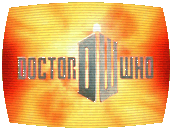 The Doctor is confronted with a mystery: a powerful signal is emanating from a backwater planet, defying any attempt to translate or decipher it, and luring ships from nearly every spacefaring race to that world. Having salvaged the severed head of a Cyberman to harness its processing power, the Doctor attaches a piece of Gallifreyan communications technology to the head, presumably capable of translating any language, much like the TARDIS herself, and “Handles” promptly identifies the planet from which the signal is transmitting as Gallifrey, though it bears no resemblance to the Doctor’s home planet. The Doctor and Clara are invited to board the first ship to have arrived here, the Papal Mainframe of the Church. The head of the Church, Tasha Lem, reveals the true name of the mystery planet: Trenzalore. The Papal Mainframe is protecting Trenzalore with a force field, but all hell will break loose the moment that the other ships realize that not only has someone been granted access to the planet, but that someone happens to be the Doctor. Upon first setting foot on Trenzalore, the Doctor and Clara find that others lie in wait, including Weeping Angels. They narrowly escape, and this time the Doctor insists on visiting Trenzalore on his terms, using the TARDIS instead of Tasha Lem’s teleport. The signal emanates from a large crack in the wall of a church tower on Trenzalore, shaped like the crack that the Doctor witnessed numerous times during his early travels with Amy and Rory. The signal is in the Gallifreyan language, repeating one question over and over: “Doctor who?” – the question that the Doctor has been warned must never be answered. Soon, the occupants of the many ships orbiting Trenzalore lose their patience, and try to invade the planet, only to find that the Doctor has given up his travels in space and time to defend it. Daleks, Cybermen, Sontarans, Weeping Angels and others attempt to land on Trenzalore, and are either driven back into space or destroyed.
The Doctor is confronted with a mystery: a powerful signal is emanating from a backwater planet, defying any attempt to translate or decipher it, and luring ships from nearly every spacefaring race to that world. Having salvaged the severed head of a Cyberman to harness its processing power, the Doctor attaches a piece of Gallifreyan communications technology to the head, presumably capable of translating any language, much like the TARDIS herself, and “Handles” promptly identifies the planet from which the signal is transmitting as Gallifrey, though it bears no resemblance to the Doctor’s home planet. The Doctor and Clara are invited to board the first ship to have arrived here, the Papal Mainframe of the Church. The head of the Church, Tasha Lem, reveals the true name of the mystery planet: Trenzalore. The Papal Mainframe is protecting Trenzalore with a force field, but all hell will break loose the moment that the other ships realize that not only has someone been granted access to the planet, but that someone happens to be the Doctor. Upon first setting foot on Trenzalore, the Doctor and Clara find that others lie in wait, including Weeping Angels. They narrowly escape, and this time the Doctor insists on visiting Trenzalore on his terms, using the TARDIS instead of Tasha Lem’s teleport. The signal emanates from a large crack in the wall of a church tower on Trenzalore, shaped like the crack that the Doctor witnessed numerous times during his early travels with Amy and Rory. The signal is in the Gallifreyan language, repeating one question over and over: “Doctor who?” – the question that the Doctor has been warned must never be answered. Soon, the occupants of the many ships orbiting Trenzalore lose their patience, and try to invade the planet, only to find that the Doctor has given up his travels in space and time to defend it. Daleks, Cybermen, Sontarans, Weeping Angels and others attempt to land on Trenzalore, and are either driven back into space or destroyed.
Involuntarily returned to Earth by the TARDIS, Clara tries to resume her day-to-day life, only to be visited by Tasha Lem, piloting the Doctor’s timeship. She wants Clara to return to Trenzalore. Hundreds of years after he last saw her, the Doctor is dying of old age, able to regenerate no more. Tasha Lem wants Clara to visit him because the Doctor shouldn’t have to die alone.
But yet another force in the universe seems to believe that the Doctor shouldn’t have to die at all.
written by Steven Moffat
directed by Jamie Payne
music by Murray GoldCast: Matt Smith (The Doctor), Jenna-Louise Coleman (Clara), Orla Brady (Tasha Lem), James Buller (Dad), Elizabeth Rider (Linda), Sheila Reid (Gran),
Mark Anthony Brighton (Colonel Albero), Rob Jarvis (Abramal), Tessa Peake-Jones (Marta), Jack Hollington (Barnable), Sonita Henry (Colonel Meme), Kayvan Novak (voice of Handles), Tom Gibbons (Young Man), Ken Bones (Voice), Aidan Cook (Cyberman), Nicholas Briggs (Dalek/Cyberman voices), Barnaby Edwards (Dalek 1), Nicholas Pegg (Dalek 2), Ross Mullan (Silent), Dan Starkey (Sontaran), Karen Madison (Weeping Angel), Karen Gillan (Amy Pond), Peter Capaldi (The Doctor)
Notes: Daleks, Cybermen (including a unique Cyberman made of wood, echoing the King and Queen from The Doctor, The Widow, And The Wardrobe), Sontarans and Angels are seen to attempt landing on Trenzalore; others, such as the Terileptils (seen in only one story, 1982’s The Visitation), are mentioned by name only. Silurian Ark ships (Dinosaurs On A Spaceship) are also seen besieging Trenzalore. The device the Doctor attaches to “Handles” is indeed a communications device given to the Master by the High Council of Gallifrey before venturing into the Death Zone with orders to rescue the Doctor (The Five Doctors, 1983); the significance
of this reference lies in what happened before the Master was given that device in The Five Doctors: he was offered “a complete new life cycle” of regenerations, something which one may infer has been granted to the Doctor by the end of this story. The Punch & Judy-style puppet show performed on Trenzalore recounts the Doctor’s misadventures with the one-eyed Monoids in The Ark (1965).
The Silence, seen throughout the eleventh Doctor’s era, are part of the Church, and stand with the Doctor to defend Trenzalore; the Silents that pestered the Doctor in seasons past (The Impossible Astronaut, Day Of The Moon, The Wedding Of River Song) were part of a rogue task group led by Madame Kovarian to prevent the Doctor from ever reaching this point; obviously that group was not successful, even when they took great pains to kidnap infant Melody Pond to program her to assassinate the Doctor. The cracks, first glimpsed in The Eleventh Hour (and, in that story, attributed to Prisoner Zero), are apparently the Time Lords attempting to signal their location to the Doctor so he can retrieve Gallifrey and return it to its proper place in reality.
LogBook entry & review by Earl Green
Review: With an interesting premise – that of the Doctor giving up his travels and settling down for hundreds of years to defend one planet from a plethora 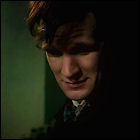 of his dreaded enemies – and an interestingly funereal atmosphere, The Time Of The Doctor is emblematic of the Moffat era: tremendously enjoyable in places, certainly memorable, but not the show firing on all cylinders like we know it’s capable of doing. Concluding the loosely connected “[insert word here] Of The Doctor” trilogy that began with The Name Of The Doctor‘s revelation of a previously unknown regeneration, and continued with Day Of The Doctor‘s exploration of that “missing Doctor”, Time Of The Doctor sneaks up behind us and whacks us over the head with another major revision to the show’s mythology: the tenth Doctor’s almost-regeneration in The Stolen Earth and Journey’s End did count against hit total number of regenerations, and the Matt Smith incarnation is, in fact, the Doctors last life.
of his dreaded enemies – and an interestingly funereal atmosphere, The Time Of The Doctor is emblematic of the Moffat era: tremendously enjoyable in places, certainly memorable, but not the show firing on all cylinders like we know it’s capable of doing. Concluding the loosely connected “[insert word here] Of The Doctor” trilogy that began with The Name Of The Doctor‘s revelation of a previously unknown regeneration, and continued with Day Of The Doctor‘s exploration of that “missing Doctor”, Time Of The Doctor sneaks up behind us and whacks us over the head with another major revision to the show’s mythology: the tenth Doctor’s almost-regeneration in The Stolen Earth and Journey’s End did count against hit total number of regenerations, and the Matt Smith incarnation is, in fact, the Doctors last life.
Unless, of course, he hits the high score and earns extra lives, right? Regardless of what charges are being leveled at Moffat for literally dropping the solution to the problem out of the sky, it’s hard to fault him for it: the limit on the 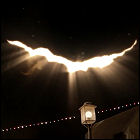 number of the Doctor’s regenerations was always going to be moved or lifted somehow. This was a goalpost that was always going to be picked up by some force of nature (or the Time Lords) and relocated a hundred yards further away. Steven Moffat was just the man sitting at the word processor when it came time to figure out exactly what the excuse would be. By weaving in a direct reference to The Five Doctors and its promise of a new regeneration cycle for the Master, Moffat is at least adhering to what’s already been established in the show’s history, and yet leaving things vague enough to make for another story later, whether it’s on his watch or not, because we don’t know who, precisely, had the authority to crack the sky and throw the Doctor a deus ex machina for the occasion. Chances are it wasn’t Rassilon. Was it the Master? Was it the grudgingly grateful General from Day Of The Doctor? Was it the Doctor’s friend Damon from Arc Of Infinity? And right now, does it matter? (The answer is: it doesn’t matter until a story worth telling can be hung on it.)
number of the Doctor’s regenerations was always going to be moved or lifted somehow. This was a goalpost that was always going to be picked up by some force of nature (or the Time Lords) and relocated a hundred yards further away. Steven Moffat was just the man sitting at the word processor when it came time to figure out exactly what the excuse would be. By weaving in a direct reference to The Five Doctors and its promise of a new regeneration cycle for the Master, Moffat is at least adhering to what’s already been established in the show’s history, and yet leaving things vague enough to make for another story later, whether it’s on his watch or not, because we don’t know who, precisely, had the authority to crack the sky and throw the Doctor a deus ex machina for the occasion. Chances are it wasn’t Rassilon. Was it the Master? Was it the grudgingly grateful General from Day Of The Doctor? Was it the Doctor’s friend Damon from Arc Of Infinity? And right now, does it matter? (The answer is: it doesn’t matter until a story worth telling can be hung on it.)
For most viewers, what mattered more here was that this was Matt Smith’s show. With Clara all but pushed into the background (doubtlessly she’ll return to the fore in the first Peter Capaldi episode while the new Doctor is busy losing and rearranging his marbles), this was Smith’s opportunity to deliver the Matt-Smith-iest performance of his Doctor Who career, and at times it’s almost too meta, what with the callback to The Big Bang‘s “drunken giraffe” dance and the all-too-close-to-reality fan mail for the Doctor, complete with 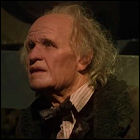 illustrations from young admirers. In a few places, Time Of The Doctor nearly stepped through the fourth wall. But at no point did Smith do anything to make me doubt that he was the Doctor, making his last stand. Surprisingly, the “middle aged” makeup applied to Smith to make him appear grey-haired was closer to taking me out of the show than the makeup applied to make him appear truly elderly. His performance at the end of the Doctor’s life was captivating and nerve-wracking for just how old and defeated he seemed; to chase that down with Smith’s Doctor warming up to what should’ve been an impossible regeneration by doing Pete-Townshend-worthy windmills (missing only the guitar) was enough to make me want to cheer. Smith was truly the star of this show, and spent his entire episode proving that he had been bringing so much more to the table since 2010 than just “that guy who was the Doctor after David Tennant.” Tennant left huge shoes to fill; I’m not entirely sure that Matt Smith doesn’t leave even bigger shoes to fill. Between holding his own in an anniversary special where he was elbow-to-elbow with the much-loved Tennant and no less an actor than John Hurt, and the tour de force that was custom-made for him here, I predict that Smith will be looked upon in the future as being as influential a Doctor as Patrick Troughton or Tom Baker. That he sometimes pulled off this utterly convincing portrayal while weighed down with occasionally substandard scripts is all the more impressive. He may yet buck typecasting and tradition and be the next Doctor who makes it big in a future role. I’ll be keeping an eye out for him.
illustrations from young admirers. In a few places, Time Of The Doctor nearly stepped through the fourth wall. But at no point did Smith do anything to make me doubt that he was the Doctor, making his last stand. Surprisingly, the “middle aged” makeup applied to Smith to make him appear grey-haired was closer to taking me out of the show than the makeup applied to make him appear truly elderly. His performance at the end of the Doctor’s life was captivating and nerve-wracking for just how old and defeated he seemed; to chase that down with Smith’s Doctor warming up to what should’ve been an impossible regeneration by doing Pete-Townshend-worthy windmills (missing only the guitar) was enough to make me want to cheer. Smith was truly the star of this show, and spent his entire episode proving that he had been bringing so much more to the table since 2010 than just “that guy who was the Doctor after David Tennant.” Tennant left huge shoes to fill; I’m not entirely sure that Matt Smith doesn’t leave even bigger shoes to fill. Between holding his own in an anniversary special where he was elbow-to-elbow with the much-loved Tennant and no less an actor than John Hurt, and the tour de force that was custom-made for him here, I predict that Smith will be looked upon in the future as being as influential a Doctor as Patrick Troughton or Tom Baker. That he sometimes pulled off this utterly convincing portrayal while weighed down with occasionally substandard scripts is all the more impressive. He may yet buck typecasting and tradition and be the next Doctor who makes it big in a future role. I’ll be keeping an eye out for him.
Time Of The Doctor isn’t perfect. I found the element of the Church, and the character of Tasha Lem, a bit off-putting, though it was easy enough to warm to Tasha Lem by the end of the episode (not that I’m pushing for “recurring” status for her; once was enough). The Church, on the other hand, was used to explain away everything from the Silents to Madame Kovarian to River Song’s kidnapping and brainwashing, and all in a talky scene across a table. But here’s where something seems amiss: way back in The Eleventh Hour, the cracks across time and space were attributed to Prisoner Zero. Now they’re Gallifrey trying to poke its nose back into our universe. And on a gut level, I honestly have a hard time believing that this actually was the plan from the beginning, with the cracks and the Silents and Madame Kovarian and River; it smacks more of a sudden attempt to tie all of the above together, rather than a calculated plan. And my evidence? If the face we know as the eleventh Doctor was the thirteenth Doctor all along, why the interrupted-regeneration feint in The Impossible Astronaut? (The real world answer, of course, is that 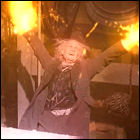 The Impossible Astronaut was long before Christopher Eccleston’s non-participation in Day Of The Doctor necessitated any kind of retroactive renumbering of the Doctor’s lives.)
The Impossible Astronaut was long before Christopher Eccleston’s non-participation in Day Of The Doctor necessitated any kind of retroactive renumbering of the Doctor’s lives.)
For both old fans and new, however, Time Of The Doctor will be remembered as a treat with a curious atmosphere, all held together, one last time, by Matt Smith’s exuberant performance. This is an almost completely unique case in which an outgoing Doctor’s last story focused almost solely upon him with laser-like intensity, and thanks in no small part to Smith, it worked.
